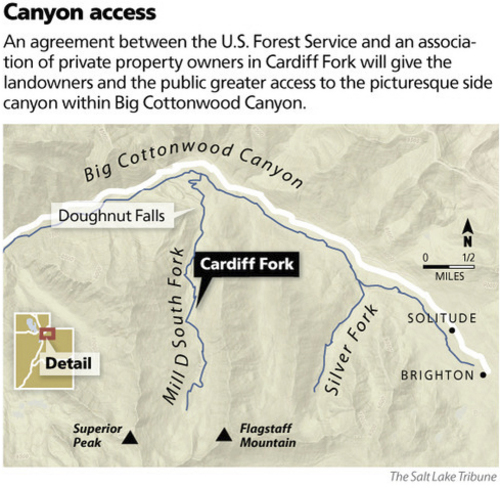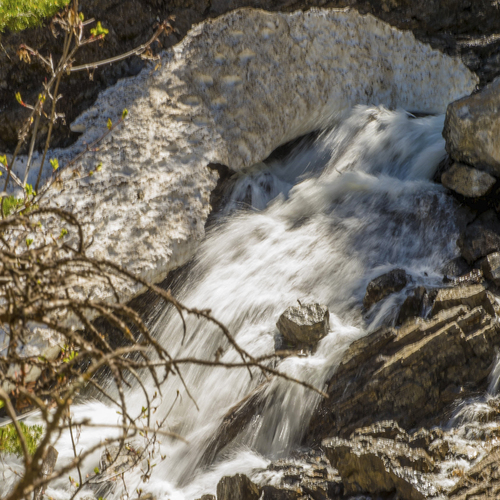This is an archived article that was published on sltrib.com in 2014, and information in the article may be outdated. It is provided only for personal research purposes and may not be reprinted.
It's not like everything has been hunky-dory since the U.S. Forest Service negotiated a three-year agreement to improve public access to Cardiff Fork, a popular offshoot of Big Cottonwood Canyon.
But all in all there have been fewer confrontations than before the 2012 truce, a disparate group of Cardiff Fork users agreed last week.
After years of friction, a special-use permit was signed in 2012 allowing summer and winter recreationists to use a dirt road to cross through private lands while hiking and skiing. It also authorized Cardiff Fork landowners to take snowmobiles and ATVs through public lands to reach their properties.
"The last two years the situation has been a lot better. I haven't heard of any direct confrontations," said Paul Diegel, executive director of the Utah Avalanche Center, referring to physical exchanges between backcountry skiers, helicopter skiers and snowmobilers. "Conflicts have gone down to a tiny fraction of what they were."
But some problems remain. Property owner Cyle Buxton came into the two-hour meeting admitting he felt a "little edgy" because "I had more vandalism last week up on my property."
As the meeting proceeded, however, Buxton said he had no doubts "things can be worked out," asking representatives of the conservation and recreation groups in attendance — including the Wasatch Mountain Club, Save Our Canyons, the Wasatch Backcountry Alliance and Wasatch Powderbird Guides — to teach their members/customers about being cognizant of private property rights.
"It's no different [in Cardiff Fork] than it is in their houses, apartments or yards," Buxton said. "So just respect it."
But as Wasatch Mountain Club President Will McCarvill observed, many of Cardiff Fork's problems are not caused by the experienced outdoors people in their organizations but by the "gumbies" who head up to the easily accessible canyon on nice days, summer and winter.
"That first couple of miles, there are people who have gotten into their cars in West Valley to go up to see Donut Falls and they're clearly ill-prepared," he said. "They have like ballet slippers on. It's clear these people don't do this a lot or think about the issues. We somehow have to reach a whole lot more people than our user groups."
One thing to do before next winter, the group concurred, is develop a better map that more clearly describes where private lands are.
That's easier said than done. While Buxton believes about 40 percent of the canyon is in private ownership, Laura Briefer, of the Salt Lake City Department of Public Utilities, thinks 12 percent is closer to the actual mark.
So coming to a consensus on how much private land exists and integrating that information into a three-dimensional canyon map has become the task of Salt Lake District Ranger Cathy Kahlow, the Forest Service official who called the meeting.
She also will solicit input on developing what backcountry skier Todd Leeds described as "a set of bullet points on how people can play together."
A consensus map and concise list of do's and don'ts will be a good starting point, agreed Save Our Canyons Executive Director Carl Fisher.
"Give all these organizations the same piece of information to shoot out to everyone," he said, "rather than having a hundred different maps that confuse everyone."
A third Cardiff Fork problem that must be addressed involves human waste. Too many people visiting the canyon do not understand the potential impacts of leaving feces in the watershed.
"There's a threat to water quality when a lot of people are pooping in the woods," Briefer said. "That's why we have sewer lines and all these regulations. I would not want to put the message out that it's fine to go into the watershed if you dig a hole deep enough."
The Salt Lake County Health Department also is concerned about the situation in Cardiff Fork. Agency official Jeremy Roberts said, "Our preference is vault toilets managed by a government entity that has the long-term funding and ability to maintain these systems."
But with no money set aside to build those expensive structures, which were not universally desired by conservationists, the group concurred that its best short-term approach might be to stash waste-collection bags at trailheads to help people clean up after themselves.
Kahlow hopes to have a map, bullet points and more information about waste matters available for the group to review prior to ski season.
"We want to promote recreational access to Forest Service property through private land while respecting private landowners' needs and desires," she said, noting that "at the end of 2015, we'll have to decide collectively whether to continue the special-use permit or to change it."
Twitter: @sltribmikeg





